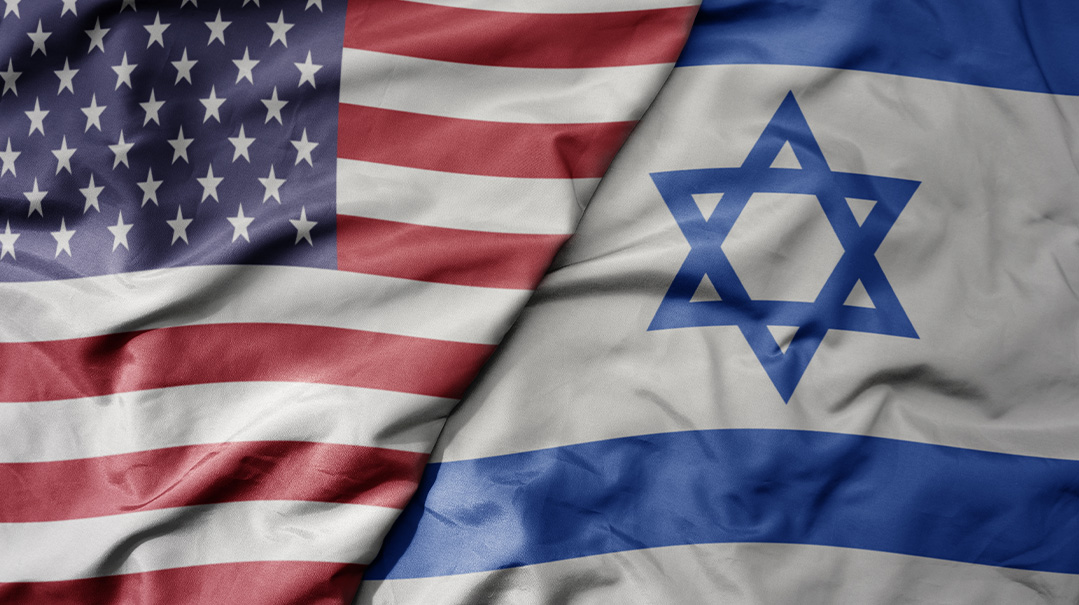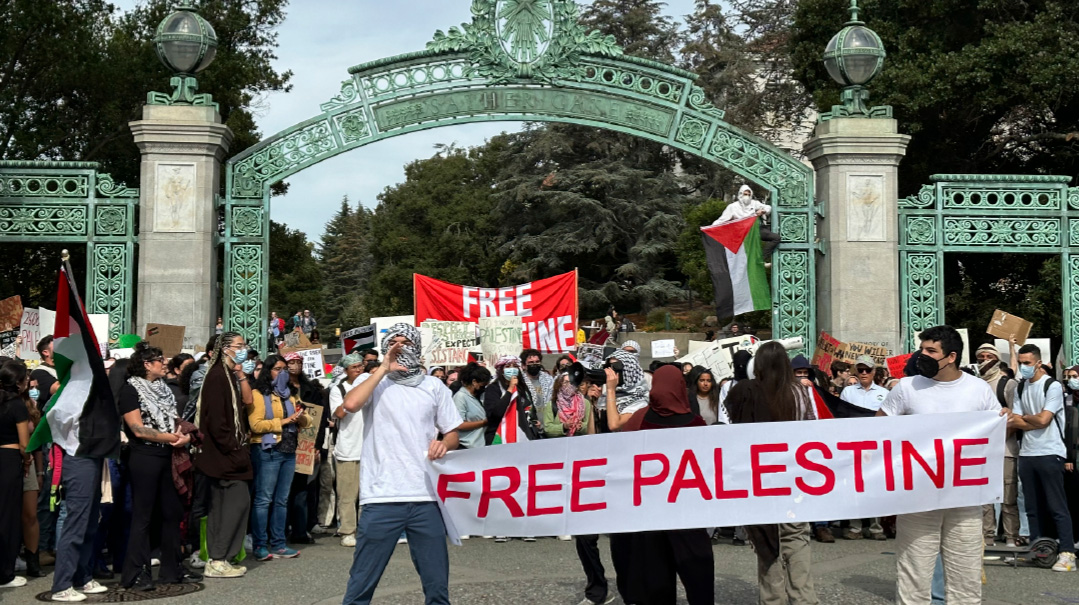Jews Take Note: Dems Are Not That into You

Jewish voters should take note and reconsider their allegiances

When I was growing up — admittedly not just yesterday — the Democratic Party was the party of the blue-collar working class, and the Republican Party that of big business and the country club set. Today, things are almost the exact opposite. The Republican Party is that of non-college-educated whites, including blue-collar workers, and most big business executives are solidly Democrats. Anheuser-Busch’s destruction of its highly profitable Budweiser Light brand with a woke advertising campaign is a good example of the dominant big business mindset.
Going back further in history, almost all blacks once voted Republican, as that was the party of Abraham Lincoln, who freed the slaves. But for decades, black voters have constituted the most solidly Democratic constituency.
In short, things change. But at least since the New Deal, one thing remains the same: Jews vote Democrat. And that would seem unlikely to change with Donald Trump, who arouses visceral feelings of disgust in most Jewish voters, athwart the Republican Party.
And yet at least one recent poll found that a majority of Jews in New York, one of the bluest of states, say they are likely to vote for Trump. Could the non-Orthodox Jewish vote now be up for grabs? Have American Jews discovered that the Democratic Party, or at least its younger, progressive wing, is “not that into us,” in the current vernacular?
OCTOBER 7 SEEMS TO have been a wakeup call for American Jewry. On that day, in the wake of most sadistic murder and torture of Jews imaginable, university campuses across the country, and numerous big cities witnessed crowds celebrating the slaughter of Jews. And that was weeks before the IDF entered Gaza or a single “innocent” Palestinian lost his or her life.
American Jews may have imagined that the Palestinians, like them, dreamed of a future of two peoples living side-by-side in harmony. And that the only thing standing in the way was the “settlements,” or the Netanyahu government (a myth the Biden administration continues to foster).
But what they learned instead, as Franklin Foer puts it in, “The Golden Age of American Jews Is Ending,” a must-read March 4 piece in The Atlantic: “The anti-Zionism that has flourished on the left in recent years doesn’t stop with calls for an end to the occupation of the West Bank. It espouses a blithe desire to eliminate the world’s only Jewish majority nation, valorizes the homicidal campaign against its existence, and seeks to hold members of the Jewish diaspora to account for the sins of a country they don’t live in and for a government they didn’t elect. In so doing, this faction of the left places itself in the terrible lineage of attempts to erase Jewry — and, in turns, stirs ancient and not-so-ancient existential fears.”
The explosion of hatred in the immediate wake of October 7 has demonstrated clearly that anti-Zionism is just another iteration of millennial anti-Semitism. Identifiable Jews have become open targets, both on campus and on city streets; “Jew” has become a common epithet; Hillel houses across the country have been defaced, and Jewish religious symbols, such as Chabad menorahs, destroyed. In a survey of campuses with significant Jewish populations, a full fifth of students says they would not want to be friends with someone who supports the existence of Israel as a Jewish state.
The open expression of Jew-hatred from the political left, the exclusion of Jewish students and social activists from groups with those they formerly viewed as allies; the lack of interest in physical attacks and constant harassment of Jewish students by university administrators, has been profoundly disorienting for American Jews.
THE LEFT IN AMERICA sets the tone of the culture. That is why the mainstreaming of anti-Semitism on the most prestigious campuses and in left-wing media has cast such a pall over American Jewry.
From the end of World War II, until at least the turn of the century, American culture, both high- and middlebrow, has not only been accepting of Jews, but in many respects heavily infused with Jewish elements. The leading American comedic figures, from Woody Allen and Mel Brooks, to Jerry Seinfeld a generation later, did not hide their Jewishness, but often highlighted it. The most frequently taught postwar American writers were largely Jewish — Saul Bellow, Joseph Heller, Bernard Malamud, Cynthia Ozick, Philip Roth — and their subjects often Jewish as well. Mid-century art criticism was dominated by Clement Greenberg and Harold Rosenberg, and literary criticism by New York Jews.
Harvard historians Louis Hartz and Daniel J. Boorstin made the case for American exceptionalism, including the absence of class-based social conflict, and helped shape a vision of a tolerant, liberal, cosmopolitan America. Elie Wiesel provided the moral conscience of the country. That same dominance of Jews extended to the sciences and economics as well. A full 15 percent of all Nobel Prize winners have been American Jews.
In the early decades of the 20th century, Ivy League schools enacted restrictive quotas to keep Jews out. But by the 60s, the Ivy League seemed more like a Jewish playground. Foer relates that Columbia University was 40 percent Jewish when he attended in the mid-90s; the University of Pennsylvania one-third Jewish; Harvard over a quarter, and Yale a fifth. So prominent were Jewish students and professors at Yale Law School in my day that one of my professors (a non-Jew) described “the permanent mission of Yale Law School as the search for an intelligent goy.” Not once did it ever occur to me growing up that being Jewish could ever be a bar to success in whatever path I chose.
Leonard Dinnerstein concluded his 1994 magnum opus, Anti-Semitism in America, with the optimistic prediction that anti-Semitism “has declined in potency and will continue to do so for the foreseeable future.”
Throughout the second half of the 20th century, Jews were not just accepted, but loved, or so we told ourselves. Didn’t the popularity of Fiddler on the Roof and Anne Frank’s Diary prove that? In 1978, ABC aired The Stars Salute Israel at 30, which featured, inter alia, Barbra Streisand schmoozing with Golda Meir by remote hookup, and concluding the festivities by belting out Hatikvah before a TV audience of 18.7 million.
That same year, Vanessa Redgrave, an ardent supporter of the PLO, denounced “Zionist hoodlums” in her Oscar acceptance speech. She was booed and subsequently reprimanded from the podium by three-time Oscar winner Paddy Chayefsky. At the post-Oscars party, Redgrave sat alone, ostracized.
By contrast, at this year’s Academy Awards, the most prominent Jewish story was of Jonathan Glazer, the Oscar-winning director of a Holocaust-themed movie, proclaiming that he “refuted his Judaism,” along with the “occupation” that has inflicted so much suffering on so many innocent people and the “hijacking of the Holocaust,” presumably by Israel to justify its own dehumanization of Gazans. (Though written out, Glazer’s statement was so syntactically garbled that it was hard to be sure what he was saying.) He received applause and no boos. Steven Spielberg, who appeared later in the program, said nothing about Glazer’s speech. Spielberg’s late mother would not have been proud.
BUT PERHAPS the clearest evidence of the end of an era of cultural ascendance for Jews in America is the Democratic Party. American Jews have long been, after black Americans, the second-most-reliable Democratic voting bloc. And Jewish megadonors account for approximately half of the party’s fundraising.
Thus, old-style Democratic polls — read Joe Biden and Hillary Clinton — instinctively reacted to Hamas’s October 7 invasion with outrage and endorsed Prime Minister Binyamin Netanyahu’s pledge to uproot Hamas from the Gaza Strip and ensure that it can never again mount such a lethal attack on Israel.
But of late, the president, at least, seems to have lost the script. That began first with demands by Biden and Secretary of State Blinken for a postwar Palestinian state. Such a state has long been the Holy Grail of American policymakers. But the basic premise upon which the two-state solution was built since the handshake on the White House lawn 30 years ago was that both sides would have to convince the other of their intention to live happily ever after in peace.
The Palestinians have made no attempt to do so — not in the present and not in the past, when their leaders turned down multiple offers of a state by Israeli prime ministers — because it would have meant recognition of the Jewish state.
Gaza has effectively been a Palestinian state, with no Jews to be found within its borders, for nearly 20 years. And how did its duly elected Hamas leaders take advantage of the opportunity for self-rule? By diverting almost all its resources to building a military force to attack Israel, a process that culminated on October 7.
As for the Palestinian Authority, revitalized or not, it has yet to utter a word of condemnation of October 7, continues to pay monthly stipends to the families of terrorists who murder Jews, and educates its children on the dream of a Judenrein Middle East. Hamas and the October 7 attacks continue to command large majority support in both Gaza and the West Bank.
Across the Israeli political spectrum, from President Herzog to opposition leader Gen. Binyamin Gantz to Gen. Amos Yadlin, former head of the Military Intelligence Directorate and former military attaché to the US, the two-state solution has no support in any headquarter.
Yet Biden has acted as if Netanyahu is the sole obstacle, and doing everything he can to bring down his government, albeit with the opposite effect of strengthening it. He declared that the Netanyahu government is doing the country more harm than good, let it be known in salty language that he loathes Netanyahu, treated Israel as a vassal state — a long time habit of Democratic administrations — by inviting the leader of the opposition to the United States for consultations with senior American officials.
For her part, Vice President Harris has finally found a cause that arouses her enthusiasm: castigating the Netanyahu government. “You must distinguish between the government of Israel and the people of Israel,” she says, a remark more appropriate with respect to a theocratic dictatorship, like Iran, than a democratically elected government.
Yet again, contrary to what Senator Schumer charged last Thursday, neither the Netanyahu government’s rejection of a Palestinian state foisted on Israel as a reward for October 7, nor its conduct of the war, has anything to do with its “right-wing” coalition partners. For all that there are many, perhaps a majority, who would like to see Netanyahu replaced, on those two issues he is well within a broad Israeli consensus.
Of late, including in his State of the Union (SOTU) speech, President Biden has focused almost exclusively on the humanitarian crisis in Gaza; the number of civilians who have died and the lack of food and medical supplies. And in the process, he has strongly implied that Israel is culpable. The Israeli military response to October 7 was “over the top” and driven by “rage,” he has said. Vice President Harris chimed in that she wanted to hear “no excuses.”
The administration has consistently cited the Hamas Health Ministry’s casualty figures — above 30,000 Gazans killed. But those figures are almost certainly not accurate. Wharton professor of statistics and data science, Abraham J. Wyner, demonstrates in a Tablet article that on their face, the Hamas numbers are manufactured. For one thing, there is little variability in casualty figures from day-to-day, as one would expect given the variability in the number of Israeli strikes. Second, the numbers of women and children killed are not correlated. Third, the number of women and children is out of all proportion to the number of men alleged to be killed.
Even if the Hamas figures of overall casualties were accurate, the ratio of civilians killed to Hamas operatives would be historically low, as we have mentioned several times. And that is despite the challenge the IDF is facing in Gaza, one far greater than that faced by American-allied forces in Mosul fighting against ISIS.
“This is the most fiendishly difficult context for urban operations since 1945, at least,” argues General David Petraeus, who turned the tide for the US in Iraq. “You have 350 miles of very well-developed tunnels, subterranean infrastructure, factories, headquarters, all these different facilities underground. You have high rises that have to be cleared. You’ve got to clear every building, every floor, every room, every cellar, every tunnel.”
Amos Yadlin relates that his American counterparts estimated that IDF casualties in Gaza would be in the thousands, whereas to date there are under 300.
But most crucial of all: “Too many” civilian casualties is not a category in either international law of morality. That claim only becomes relevant if one specifies what could have been done differently to achieve the same objectives without incurring so many casualties. But casualties incurred because an enemy places its military assets among the civilian population are attributable to the party doing so — in this case Hamas. Senator John Fetterman has made this point numerous times with admirable clarity.
If one cannot specify how Israel should respond to horrific mass attacks on its civilians, against an enemy hiding among its own civilian population, without killing “too many” civilians, then one is effectively saying that Israel has no right to defend itself — i.e., exist in any borders. Of course, that is precisely what all those chanting “from the river to the sea” do say. But Israel cannot be expected to agree to calls for its destruction.
“Proportionality” in international law refers to the importance of the military objective in relation to the civilian casualties. Israel’s military objective could not be of higher importance: the very survival of Israel. Comparisons to the 1948 War of Independence are by now commonplace. If Hamas emerges still in control of Gaza, farmers will never return to the area around Gaza. And if Israel is stripped of its deterrent capacity, either because it fails to defeat Hamas or because American and international pressure forces it to cease military operations, Hezbollah will be emboldened, and tens of thousands of Israeli evacuees from the North will never return to their homes, either.
If an Israeli response to the horrific and unprovoked attack of October 7 provokes an outcry of “too many” casualties, how much greater will be the outcry if Israel is forced to attack Hezbollah preemptively, in response to its ongoing rocket attacks? Because the Hezbollah threat is so much greater, Israel would be forced to lay much of southern Lebanon to waste in a very short period of time, to prevent Hezbollah from launching its 130,000 missiles, many of them precision guided.
Not one Israeli politician or military figure has suggested that the war might end without an assault on Rafah, Hamas’s last remaining stronghold. Opposition leader and former chief of staff, Benny Gantz, should probably not have accepted an invitation to D.C., but once there, he made clear to the president that firefighters do not walk away when 80 percent of the fire has been extinguished, and let it rekindle to its former intensity.
And yet ominously, post-SOTU, President Biden termed a major Israeli assault on Rafah a “red line,” and seven Democratic senators are threatening congressional action to block US arms sales to Israel if it launches a major action in Rafah, on the flimsy grounds that Israel is denying humanitarian relief to Gazan civilians. But the problem in Gaza is not a lack of food or Israel’s willingness to bring in food — more food trucks are arriving than prior to October 7 — it is that armed Hamas fighters seize most of the food that comes in for themselves.
Now, let me get to the point of this lengthy indictment of the Biden administration’s recent policies and pronouncements with regard to Israel’s war on Hamas. I don’t know whether Joe Biden is a gentile Zionist in his heart, as he often proclaims, or whether he imbibed the considerable animus to Israel of his former boss, Barack Obama.
What concerns me is that he feels compelled to adopt these policies in order to retain the support of the progressive wing of the Democratic Party in November. He has been spooked by the 100,000 young, progressive and Palestinian voters for an uncommitted delegate slate in the recent Michigan Democratic primary. And likely by the mini-revolts among younger White House and State Department staffers against administration support for Israel.
If evincing hostility to Israel is the price that Democratic candidates must pay to retain the support of those younger voters being marinated in anti-Israel and anti-Jewish hatred on university campuses, Jewish voters should take note and reconsider their allegiances.
(Originally featured in Mishpacha, Issue 1004. Yonoson Rosenblum may be contacted directly at rosenblum@mishpacha.com)
Oops! We could not locate your form.







